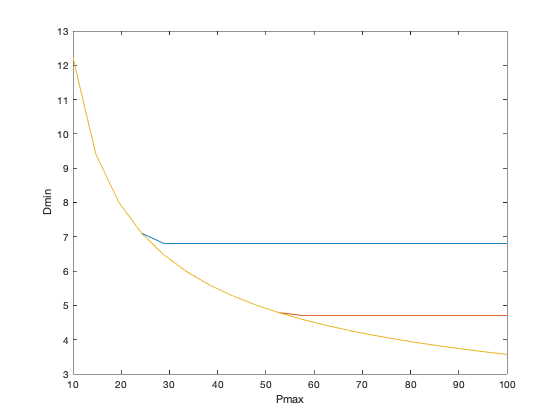m = 7;
n = 8;
A = sparse(m,n);
A(1,1) = 1;
A(2,2) = 1;
A(2,3) = 1;
A(3,4) = 1;
A(3,8) = 1;
A(4,1) = -1;
A(4,2) = -1;
A(4,5) = 1;
A(4,6) = 1;
A(5,3) = -1;
A(5,4) = -1;
A(5,7) = 1;
A(6,5) = -1;
A(7,6) = -1;
A(7,7) = -1;
A(7,8) = -1;
Aout = double(A > 0);
Ain = double(A < 0);
f = [1 0.8 1 0.7 0.7 0.5 0.5]';
e = [1 2 1 1.5 1.5 1 2]';
Cout6 = 10;
Cout7 = 10;
a = ones(m,1);
alpha = ones(m,1);
beta = ones(m,1);
gamma = ones(m,1);
N = 20;
Pmax = linspace(10,100,N);
Amax = [25 50 100];
min_delay = zeros(length(Amax),N);
disp('Generating the optimal tradeoff curve...')
for k = 1:length(Amax)
fprintf( 'Amax = %d:\n', Amax(k) );
for n = 1:N
fprintf( ' Pmax = %6.2f: ', Pmax(n) );
cvx_begin gp quiet
variable x(m)
variable t(m)
minimize( max( t(6),t(7) ) )
subject to
cin = alpha + beta.*x;
cload = (Aout*Ain')*cin;
cload(6) = Cout6;
cload(7) = Cout7;
d = cload.*gamma./x;
power = (f.*e)'*x;
area = a'*x;
x >= 1;
power <= Pmax(n);
area <= Amax(k);
Aout'*t + Ain'*d <= Ain'*t;
d(1:3) <= t(1:3);
cvx_end
fprintf( 'delay = %3.2f\n', cvx_optval );
min_delay(k,n) = cvx_optval;
end
end
plot(Pmax,min_delay(1,:), Pmax,min_delay(2,:), Pmax,min_delay(3,:));
xlabel('Pmax'); ylabel('Dmin');
disp('Optimal tradeoff curve plotted.')
Generating the optimal tradeoff curve...
Amax = 25:
Pmax = 10.00: delay = 12.21
Pmax = 14.74: delay = 9.41
Pmax = 19.47: delay = 8.01
Pmax = 24.21: delay = 7.11
Pmax = 28.95: delay = 6.80
Pmax = 33.68: delay = 6.80
Pmax = 38.42: delay = 6.80
Pmax = 43.16: delay = 6.80
Pmax = 47.89: delay = 6.80
Pmax = 52.63: delay = 6.80
Pmax = 57.37: delay = 6.80
Pmax = 62.11: delay = 6.80
Pmax = 66.84: delay = 6.80
Pmax = 71.58: delay = 6.80
Pmax = 76.32: delay = 6.80
Pmax = 81.05: delay = 6.80
Pmax = 85.79: delay = 6.80
Pmax = 90.53: delay = 6.80
Pmax = 95.26: delay = 6.80
Pmax = 100.00: delay = 6.80
Amax = 50:
Pmax = 10.00: delay = 12.21
Pmax = 14.74: delay = 9.41
Pmax = 19.47: delay = 8.01
Pmax = 24.21: delay = 7.11
Pmax = 28.95: delay = 6.46
Pmax = 33.68: delay = 5.97
Pmax = 38.42: delay = 5.59
Pmax = 43.16: delay = 5.27
Pmax = 47.89: delay = 5.01
Pmax = 52.63: delay = 4.79
Pmax = 57.37: delay = 4.71
Pmax = 62.11: delay = 4.71
Pmax = 66.84: delay = 4.71
Pmax = 71.58: delay = 4.71
Pmax = 76.32: delay = 4.71
Pmax = 81.05: delay = 4.71
Pmax = 85.79: delay = 4.71
Pmax = 90.53: delay = 4.71
Pmax = 95.26: delay = 4.71
Pmax = 100.00: delay = 4.71
Amax = 100:
Pmax = 10.00: delay = 12.21
Pmax = 14.74: delay = 9.41
Pmax = 19.47: delay = 8.01
Pmax = 24.21: delay = 7.11
Pmax = 28.95: delay = 6.46
Pmax = 33.68: delay = 5.97
Pmax = 38.42: delay = 5.59
Pmax = 43.16: delay = 5.27
Pmax = 47.89: delay = 5.01
Pmax = 52.63: delay = 4.79
Pmax = 57.37: delay = 4.60
Pmax = 62.11: delay = 4.43
Pmax = 66.84: delay = 4.28
Pmax = 71.58: delay = 4.15
Pmax = 76.32: delay = 4.03
Pmax = 81.05: delay = 3.92
Pmax = 85.79: delay = 3.82
Pmax = 90.53: delay = 3.73
Pmax = 95.26: delay = 3.65
Pmax = 100.00: delay = 3.57
Optimal tradeoff curve plotted.

